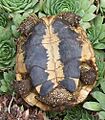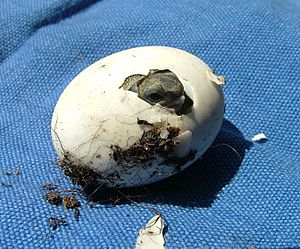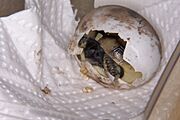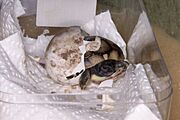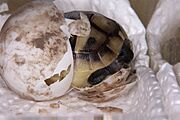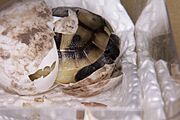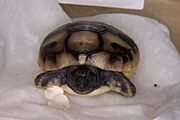Hermann's tortoise facts for kids
Quick facts for kids Hermann's tortoise |
|
|---|---|
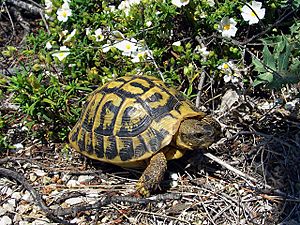 |
|
| Testudo hermanni hermanni on Majorca | |
| Conservation status | |
| Scientific classification | |
| Genus: |
Testudo
|
| Species: |
hermanni
|
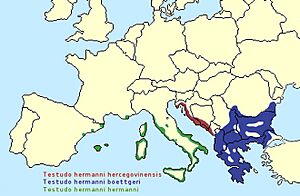 |
|
| Range map. Western green population is hermanni, eastern blue boettgeri and red hercegovinensis. |
|
| Synonyms | |
|
|
The Hermann's tortoise (Testudo hermanni) is a type of tortoise that lives in Europe. These tortoises are known for their beautiful shells and gentle nature. They are popular pets in many parts of the world.
Contents
What's in a Name?
The scientific name for this tortoise, hermanni, was chosen to honor Johann Hermann. He was a French naturalist, someone who studies nature.
The name for one of its subspecies, boettgeri, honors a German scientist. His name was Oskar Boettger, and he studied reptiles and amphibians.
Types of Hermann's Tortoises
There are two main types, or subspecies, of Hermann's tortoise. They are the western Hermann's tortoise (T. h. hermanni) and the eastern Hermann's tortoise (T. h. boettgeri).
Western Hermann's Tortoise
The western Hermann's tortoise has a shell that is quite rounded. Its shell has bright yellow and dark patches that stand out. As the tortoise gets older, the colors might fade a little. But the bright yellow often stays clear. The bottom part of its shell usually has two black bands. These bands are connected along the middle.
The head of this tortoise can be dark green or yellowish. It often has dark spots. Many western Hermann's tortoises have a yellow spot on their cheek. Their front legs usually do not have black spots underneath. The base of their claws is often light-colored. Male tortoises have a tail that is bigger than females'. Their tails also have a spike at the end. The shell that covers the tail is usually split into two parts.
Eastern Hermann's Tortoise
The eastern Hermann's tortoise also has a rounded shell. Some of them can be flatter or more oval-shaped. Their shells are brownish with yellow or greenish colors. They also have black spots. The colors on older eastern tortoises tend to fade a lot. The bottom of their shell is usually a solid horn color. It has separate black patches on each side of the middle.
Their heads are brown to black and have small scales. Their front legs also have fine scales. They usually have five claws on each leg, which are dark at the base. Their back legs are thicker than their front legs. The tail of an eastern Hermann's tortoise has a strong spike at the end. This spike can be very big on older males. Females have smaller tail spikes that are slightly bent. These tortoises can live for about 70 to 80 years.
-
Adult female, Bulgaria
Where They Live
Hermann's tortoises can be found all over southern Europe. The western type (T. h. hermanni) lives in places like eastern Spain, southern France, and islands such as Corsica and Sicily. They also live in southern and central Italy.
The eastern type (T. h. boettgeri) lives in countries like Serbia, Bulgaria, Greece, and parts of Turkey. Another group, T. h. hercegovinensis, lives along the coasts of Bosnia and Herzegovina, Croatia, and Montenegro.
Hermann's tortoises were also brought to islands like Sardinia and Cyprus by people a long time ago.
What They Look Like
Hermann's tortoises are small to medium-sized. Young ones and some adults have beautiful black and yellow patterns on their shells. Over time, these bright colors might become a duller gray, straw, or yellow. They have a slightly hooked upper jaw. Like other tortoises, they don't have teeth. Instead, they have strong, hard beaks.
Their legs are scaly and gray to brown, with some yellow marks. Their tails have a spur, which is a hard spike, at the tip. Adult males have longer and thicker tails with very clear spurs. This helps tell them apart from females.
The eastern subspecies (T. h. boettgeri) is usually bigger than the western one (T. h. hermanni). Eastern tortoises can grow up to 28 cm (11 in) long. A tortoise this size might weigh 3–4 kg (6.6–8.8 lb). Western tortoises rarely grow bigger than 18 cm (7.1 in). Some adults can be as small as 7 cm (2.8 in).
Daily Life and Habits
Early in the morning, Hermann's tortoises leave their shelters. These shelters are usually hollows under thick bushes. They come out to warm up in the sun. After basking, they look for food in the Mediterranean meadows where they live. They use their sense of smell to find plants to eat.
What They Eat
In the wild, they eat many kinds of wildflowers. If you have a tortoise as a pet, you need to be careful. Some flowers, like buttercups, are bad for them. Plants like dandelion and kale have something called oxalic acid. Too much of this can hurt their kidneys over time. So, it's important to give them a variety of safe wildflower leaves.
Special food pellets for tortoises are not good for Hermann's tortoises. They can become addicted to them. This can make them grow too fast and refuse to eat natural foods. Some foods, like tomatoes and cabbage, might seem tasty to them but can be harmful. Tortoises also eat small amounts of fruit as a treat, but only sometimes.
Around midday, the sun gets too hot. The tortoises go back to their hiding spots to cool down. They have a good sense of direction to find their way back. In the late afternoon, they come out again to eat more.
Reproduction and Life Cycle
In late February, Hermann's tortoises wake up from their winter sleep. They spend winter hibernating under bushes or old wood. They bury themselves in dead leaves. Right after waking up, they start looking for mates.
Mating can be a bit rough for the female. The male chases her, bumps into her, and bites her before mating. Males also fight each other during mating season. They might ram into each other.
Between May and July, female tortoises lay their eggs. They dig flask-shaped nests in the soil, about 10 cm (3.9 in) deep. Each nest holds between two and 12 eggs. Most females lay more than one group of eggs each year. The eggs are pinkish-white and hatch in about 90 days.
The temperature of the eggs determines if they will be male or female. If the eggs are kept at 26 °C, only males will hatch. If they are at 30 °C, all the babies will be female. Young tortoises usually hatch in early September, when the heavy autumn rains begin. For their first four or five years, they stay very close to their nests. If there isn't enough rain, or if the eggs were laid late, the babies might stay underground. They will then come out the next spring.
Young tortoises are very vulnerable until their hard shells fully develop, around age six to eight. Many animals, like rats, badgers, foxes, and wild boar, can prey on them. If they survive these dangers, Hermann's tortoises can live for about 30 years. Some sources say they might live 90 years or even more!
Hibernation
In nature, Hermann's tortoises dig shelters for the night. They spend the mild Mediterranean winters there. During this time, their heart rate and breathing slow down a lot. If you have a pet tortoise, you can help it hibernate. You can keep it in a large, rodent-proof box in a cool basement. The box should have a thick layer of dry leaves. The temperature should be around 5 °C.
Another way is to keep the box in a refrigerator. If you use a refrigerator, make sure it's opened regularly for air flow. The temperature must not drop below freezing (0 °C). Adult tortoises can sleep for four to five months during hibernation.
Keeping Them as Pets
Hermann's tortoises can be kept indoors if they have the right living conditions. They need a heat lamp set between 15–30 °C (59–86 °F). This creates a warm spot for them to bask. They also need a UVB light bulb. This light helps their bodies make vitamin D3, which is important for healthy bones. It prevents problems like metabolic bone disease.
Protecting Hermann's Tortoises
Hermann's tortoises are listed in Appendix II of the Convention on International Trade in Endangered Species (CITES). This means that if you want to move them between countries, you need special papers. This helps control their trade and protect them.
People have started programs to help save these tortoises. For example, in 1989 and 1990, tortoises were brought back into their natural homes. Fences were also put up to keep them safe from cars on highways. These efforts have helped increase the number of tortoises in the wild.
See also
- Mediterranean tortoise
- List of reptiles of Italy
- Jackson ratio









